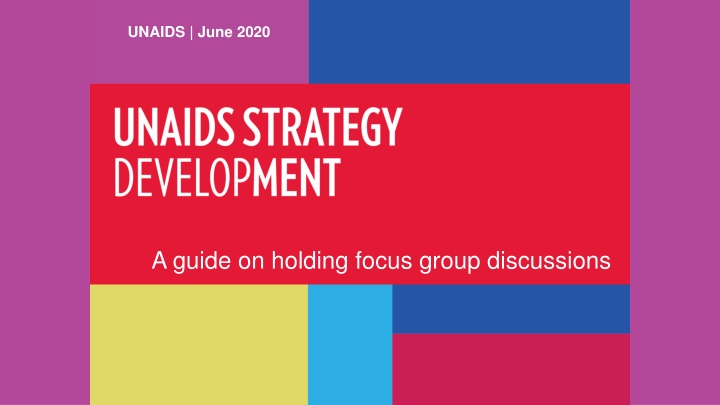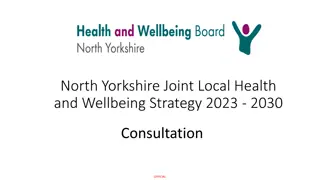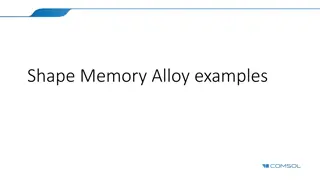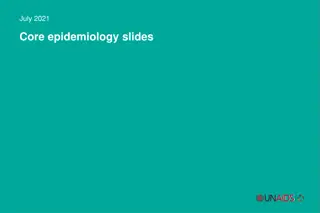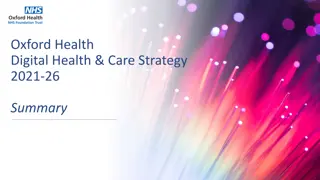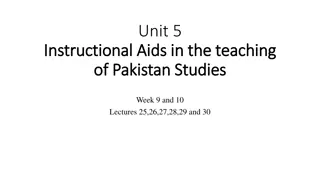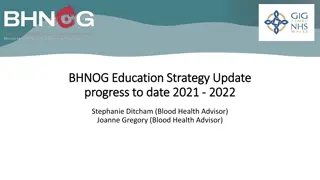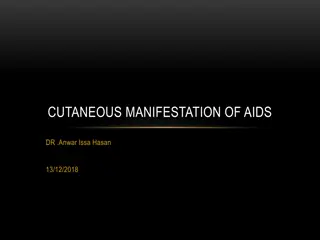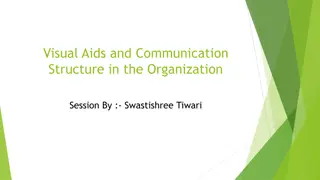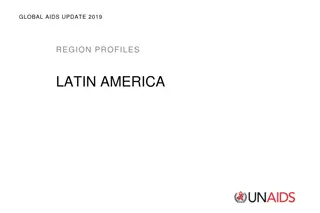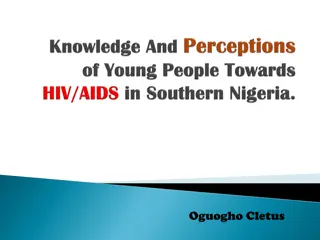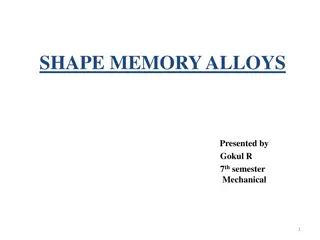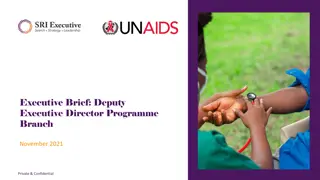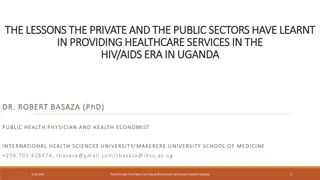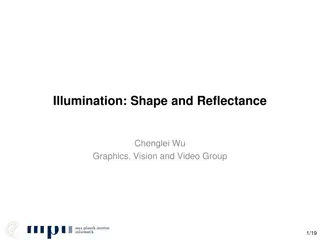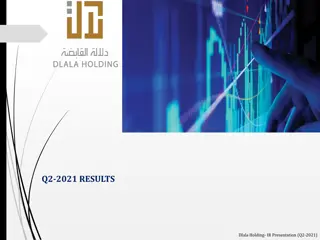Guide for Holding Focus Groups to Shape AIDS Strategy Beyond 2021
This guide explores the importance of holding focus group discussions to shape an effective AIDS strategy beyond 2021, with the aim of ending AIDS by 2030. As the clock ticks towards this critical deadline, the need for proactive and inclusive strategies becomes paramount in the fight against the public health threat of AIDS.
Download Presentation

Please find below an Image/Link to download the presentation.
The content on the website is provided AS IS for your information and personal use only. It may not be sold, licensed, or shared on other websites without obtaining consent from the author.If you encounter any issues during the download, it is possible that the publisher has removed the file from their server.
You are allowed to download the files provided on this website for personal or commercial use, subject to the condition that they are used lawfully. All files are the property of their respective owners.
The content on the website is provided AS IS for your information and personal use only. It may not be sold, licensed, or shared on other websites without obtaining consent from the author.
E N D
Presentation Transcript
UNAIDS | June 2020 A guide on holding focus group discussions
The need for an AIDS Strategy beyond 2021 With less than 10 years to go to reach the goal of ending AIDS as a public health threat by 2030, the Programme Coordinating Board (PCB) tasked UNAIDS to review the UNAIDS 2016-2021 Strategy: On the Fast Track to end AIDS, taking stock of the significant gains already made and assess areas not on track to reach the targets, especially for the most vulnerable in society. The AIDS strategy beyond 2021 will present a roadmap and pathways to guide our collective efforts to overcome challenges and ensure effective country- led AIDS responses present with new global targets and resource needs estimates for 2025 address how HIV responses continue to meet the needs of people living with and affected by HIV, while at the same time respond to the current COVID-19 pandemic and any future emerging challenges. The COVID-19 pandemic exposes the fragility of the global political, financial and health architecture and the inter- connectedness of health and social and economic vulnerabilities. It has highlighted the need for continuity of HIV-related services to ensure positive health outcomes of people living with HIV who may acquire COVID-19 and it has magnified the very same vulnerabilities in societies and sub- populations. It has also shown how the lessons learned from responding to the AIDS pandemic can be put to practice and respond with speed to a devastating new pandemic.
Principles underpinning the Strategy Development process We are committed to ensuring that the strategy produces interventions and responses that work for those that are currently unreached and left behind. Inclusive, participatory, interactive, multi-sectoral and multi-level to fully inspire inputs from everyone, particularly those whose voices are not often heard due to stigma, marginalisation and exclusion For this reason the process must be: Self-reflective and explore the successes, challenges and failures in the AIDS response and be reflective of the global health, human rights, and development context beyond HIV Innovative in how to explore partnerships and synergies with other health and development responses, while remaining focused on reaching the goal of ending AIDS by 2030 despite a challenging context
Strategy development process at a glance 46th UNAIDS Programme Coordinating Board meeting Special session UNAIDS PCB adoption of Strategy Multistakeholder consultation strategic priorities 23-25 June Data review published 47th UNAIDS programme Coordinating Board meeting Results of review inform subsequent consultations 2020 2021 May Jun Jul Aug Sep Oct Nov Dec Jan Feb March Analysis of available data and evidence Online survey, interviews, focus group discussions Workshops, aligning priorities and set directions Strategy drafting and review
Focus Group Discussions (FGDs) Seeking out diversity of voices and perspectives Allow a safe space for dialogue and surfacing of different positions and perspectives on how to deliver an effective HIV response; Understand the changing external political, financial and health and development context and its impact on how the response to HIV continues; Guiding objectives Understand the underlying root causes that prevent achieving goals specific to HIV and broadly in health and development. Explore lessons learnt, successful and unsuccessful strategies from and beyond the HIV response. Build a shared understanding of what the approach could be for the next 5 years with insights on what to stop, start and continue.
Where do YOU come into play? Strategy survey Focus Group discussions The online survey is available to anyone who More structured discussions, allowing would like to voice their opinion about what the dialogue to explore a thematic area in- UNAIDS Strategy beyond 2021 should be. depth, and identify recommendations for the Strategy A set of multiple choice questions Discussions can focus on a theme, a Anyone can take the survey, regardless of geographic area or on specific populations their role in the HIV response. An opportunity for multistakeholder dialogue
UNAIDS and self-organized discussions UNAIDS will lead on a set of thematic global focus group discussions (June - August 2020) and UNAIDS will support others who would like to organize focus group discussions To ensure maximum inputs from UNAIDS stakeholders, self-organised groups are invited to explore and identify themes and/or geographic focuses for in-depth dialogues. We encourage anyone interested in holding a focus group discussion to inform us at strategyteam@unaids.org and we can provide further guidance and support as you plan and prepare for the discussion.
The format and platform 01 02 03 04 Taking into consideration COVID-19 measures A 3-hour conversation On a virtual platform such as Zoom Suggested for 20-25 participants Where it is possible to meet in person, while observing local context social distancing measures NB: The agenda design includes breakout rooms. The guide uses the functionality of a paid for Zoom account as the virtual platform. If you are not using Zoom, please check that your preferred platform has this functionality. NB: The agenda design includes breakout rooms. The guide uses the functionality of a paid for Zoom account as the virtual platform. If you are not using Zoom, please check that your preferred platform has this functionality. The meeting agenda can be adapted to in-person discussions.
Before the focus group discussion Choose a platform to use Review the agenda Choose a Facilitator Decide how to run breakout rooms Identify the theme
Before moving on Do you have questions? Do you want support to organise a discussion? Do you want to make a suggestion for a theme? Contact us at strategyteam@unaids.org and we can provide further guidance and support as you plan and prepare for the discussion.
This guide 01 02 a suggested agenda with facilitators notes 03 tips for facilitation and details on specific exercises 04 a glossary of terms a reporting format for synthesising the discussions
The agenda, an abbreviated version Process Final checks on technology Early check in to welcome participants as they join the call Time -30 minutes 0h00 0h10 0h10 0h25 0h25 0h30 0h30 0h45 0h45 1h00 1h00 1h35 1h35 1h50 1h50 2h00 2h00 2h10 2h10 2h45 2h45 2h55 2h55 3h00 Opening session and introducing the UNAIDS Strategy and process Introductions of participants Contracting for the session: ground rules, ways of working in a virtual meeting Framing the subject: a brief presentation on the issue Introducing break-out session: People-centered lens, the concept and instructions for groups Group discussions: the person, the services, the external context Plenary: report back Break Individual journaling World caf : Continue, Stop, Start Plenary report back, the one key recommendation Check out
From now on the timeline will be color- coded based on the person in charge: Facilitator Notes for the facilitator Tech facilitator
Getting ready -30 to 0 minutes 0 to 10 minutes Welcome and opening of session Frame the purpose of the session Say a few words on the global strategy on AIDS. Facilitator Welcome participants as they join and communicate on tech-etiquette Invite the host organization for welcoming remarks Encourage participants that their presence is as important during a virtual FGD as it is in a face-to- face setting. You may wish to emphasize the following agreements: Have your camera turned on. Mute yourself when you are not speaking. Turn off all applications notifications (emails, text, WhatsApp, etc.). Have Zoom in full screen mode (so as not to be distracted by other open windows) Notes for facilitator Ensure that the speaker later on in the session is co-host so they can share their screen for the presentation. Check prior that the speaker is comfortable with screen sharing in zoom. Make sure everyone is on mute Tech / notetakers Final checks on technology and connectivity Ensure you are the main host for the call. Orient those who might not be familiar with zoom and tech platforms being used.
Opening the session Facilitator 10 to 25 minutes 25 to 30 minutes Contracting of the session. Invite participants to introduce themselves by sharing name and organization Notes for facilitator Allow for 30sec or 1 min per person (depending on number of participants) Establish ground rules for the focus group Request participants to enter in the chat box How do we want to be in our time together? Request participants to enter in the chat box: Name Organization What contribution do you hope to make to this meeting? Tech / notetakers Monitor and note participants entry in the chat box Monitor and note participants entry in the chat box
Setting the scene 30 to 45 minutes Facilitator Framing the subject (2 minutes) Invited speaker presentation to guide the line of inquiry in the conversation, to frame the subject (7 minutes) Invite clarifying questions from participants (5 minutes) Notes for facilitator Invite the speaker to present, note time, Recommended 5 slides maximum The issue, why it must be discussed Evidence illustrating the issue/trends The challenges, barriers, risks, etc. Successes/ideas on solutions/etc. What can be done? Screen share presentation Enable screen sharing for participants in your settings or make the expert who is speaking a co-host. Tech / notetakers
Introducing the breakout groups 45 to 60 minutes Facilitator Introduce the approach to use during breakout groups (see suggestion below and next page) In our discussions we need to focus on the next 5 years, looking into the future and leaving behind the past. Allow for 5 minutes for participants to discuss the idea of the 3 circles and ensure there is a shared vision on how these circles are viewed. Provide instructions on how participants are assigned to each group and what questions will guide their discussions Before leaving for groups, invite participants to spend 5 minutes on individual journaling, to prepare for the groups Let participants know they will see a join breakout room button, they should click to join the room. As co-host you can join different breakout rooms to check on participant progress. At the end of the session, you will need close the breakout rooms and participants will automatically return back to the main room. (Review accompanying how to use Zoom presentation) As the session facilitator is introducing the session start setting up the breakout room sessions. If using a pre-created list, choose the manual option for setting up breakout room; if assigning groups randomly, choose the automatic option and select the number of rooms (6 for 25 participants; about 4 in each group). Notes for facilitator Tech / notetakers
How to guide the breakout groups Framing the discussions in the groups In our discussions we need to focus on the next 5 years, looking into the future and leaving behind the past. Committed to a people-centered response to HIV, this session is designed to narrow down as fast as possible to the main challenges or success factors that have the greatest impact on our ability to reach people in need? We will break out into smaller groups, and each will focus on one of the three areas - 2 groups will focus on Reaching the people in need - 2 groups will focus on The structures that respond to HIV - 2 groups will focus on Contextual environment Breakout conversation will be guided by the following questions: How do we see the current situation? What concerns us? What gives us hope? What constrains our ability to achieve our goals? Who goes where The groups can be Randomly be selected OR Preassigned and facilitator will announce who is going to be in which group Before the session Assign participants to groups (optional) Create a Google Doc template that participants can use to type their notes (see below) Upload the word template and copy the link for sharing with editing permissions.
Template to be used by participants during breakout groups Reaching the people in need The structures that respond to HIV Contextual environment
Group discussions 1h00 to 1h35 minutes 1h35 to 1h50 minutes Facilitator Every group to assign one person from their group as a timekeeper and one person to take notes and who will report back in plenary. Plenary report back and visual harvesting Use guiding questions to frame discussions OPTIONAL: visual harvest while screensharing using template on the following slide Notes for facilitator Monitor throughout the session for participants who may need help Tech / notetakers Post-questions in chat box. Post google document template Open breakout rooms Broadcast questions again to the breakout rooms; Broadcast Google doc link again. Monitor together with the facilitator throughout the session for participants who may need help
01h5002h00 (10 minutes) - Break Do you have questions? Do you think you could you a clarification? Do you ant to make a suggestion? Contact us at strategyteam@unaids.org and we can provide further guidance and support as you plan and prepare for the discussion.
World Caf 2h00 to 2h10 minutes 2h10 to 2h45 minutes Facilitator Individual journaling (5 minutes) World Caf What are the key recommendations back to UNAIDS in terms of the strategy specifically (in detail?)? CONTINUE: What is working that we must continue to do? STOP: What must we stop doing, if not stopped will ensure failure START: What are we not doing that we must start doing? Plenary, what patterns are emerging from the conversations we have had? (5 minutes) Monitor throughout the session for participants who may need help Notes for facilitator Ask 2-3 people to share in plenary and for different observations if any to be added to the chat box. Break participants into 4 mixed groups. 3 rounds of 10 mins each Tech / notetakers Set-up breakout rooms, automatic/randomly into 6 groups Share the same google doc template link
Closing 2h55 minutes to 3h00 2h45 to 2h55 minutes Facilitator Plenary report back Check out, closing the session What is the one key recommendation we want to reiterate for strong consideration? Chat-box: What can I not leave this focus group without saying? Notes for facilitator From what was entered into templates, determine common threads Ask 2-3 people to share in plenary and for different observations if any to be added to the chat box. Tech / notetakers Record notes from participants in chatbox
Tips for facilitation and details on specific exercises 02 While not all facilitation has the same goals, we believe that the next few pages give a good outline of what needs to occur during any kind of facilitation whatever you are supporting teams to accomplish. The list also gives a sense of the breadth of issues to pay attention to as we hold space. While not all facilitation has the same goals, we believe that the next few pages give a good outline of what needs to occur during any kind of facilitation whatever you are supporting teams to accomplish. The list also gives a sense of the breadth of issues attention to as we hold space. to pay
The concept to guide the breakout rooms A people centred-approach Contextual environment 03 The structures that respond to HIV 02 Reaching the person in need 01
The concept to guide the breakout rooms A people centred-approach Reaching the person in need 01 Focusing on marginalized groups and maintaining access for those that were reached with prevention and treatment. The structures that respond to HIV 02 In a nutshell, this is the AIDS response; The structures and organisations that directly implement the AIDS Strategy. This includes but is not limited to the Joint Programme, Global Fund, PEPFAR, and most importantly, the national partners implementing the National AIDS Plan. Contextual environment 03 The external context, beyond HIV, that can have an impact either because the response to HIV fits within a larger issue (e.g., SDG3 and Agenda 2030, Universal health coverage) or because of emerging issues that will impact services, funds, or priorities (e.g., COVID-19 pandemic, natural disasters or humanitarian crises). Some of the issues could be driving forces in the world that we can engage and influence for a more effective AIDS response, and some we have no control over, but which have significant impact on our work.
The concept to guide the breakout rooms A people centred-approach To keep in the centre of the work the people we are trying to reach and focus our discussions on challenges or success factors that have the greatest impact on our ability to reach the person. This helps to ground the process in the person. Why we use it When we use it Before we launch a conversation or breakout room to explore challenges in the HIV response. Who is involved One facilitator introduces the concentric circle and the tech facilitator shares the google template for participants to record results of conversations
Virtual meeting In person meeting Use of a projector or printed version of the concentric circles. Familiarise yourself with the descriptions of the different circles and have the image on a presentation or close-by for sharing Spend 5 minutes in plenary having a conversation about the concentric circles so that when participants move to smaller groups, there is a shared vision of how these concentric circles are viewed. Spend 5 minutes in plenary having a conversation about the concentric circles so that when participants break to breakout rooms, there is a shared vision of how these concentric circles are viewed. Prompting question Are there any additions to the descriptions we have used? Prompting question Are there any additions to the descriptions we have used? Invite individual journaling time for 5 minutes. Invite individual journaling time for 5 minutes. Tech facilitator could use this time to set-up breakout rooms if they are not ready yet. Explain that participants have to assign a note-taker in their small groups, and remind them to use the template provided to respond to the following questions: Explain that participants will have to accept a breakout room invitation button, assign a note-taker, timekeeper, and remind them to use the template provided to respond to the following questions: How do we see the current situation? What concerns us? What gives us hope? What constrains our ability to achieve our goals? How do we see the current situation? What concerns us? What gives us hope? What constrains our ability to achieve our goals? Keep track of time and circulate around the room to make sure participants are working and be attentive to clarification questions. Close the breakout rooms and move to plenary for reporting and discussion, asking for the key headlines.
Check-in and check out Why we use it To build trust and transparency in the team To democratize the plenary space and flatten hierarchy in the team everyone is invited to participate To get a sense of what the participants are thinking. When we use it At the beginning of each session At the end of each session Who is involved One facilitator asks the questions and holds the space for this process Basic instructions Prepare your questions ahead of time (include them in your agenda template) Be willing to change or adapt your questions each day based on what is coming up in the group, and is most relevant at that moment Always use open-ended questions
Contracting ground rules Why we use it To build trust and transparency in the team; To democratize the plenary space and flatten hierarchy in the team everyone is subject to the same rules of engagement for this session; Because being present (i.e. not checking cell phones, not thinking about other business, not just debating with colleagues in the meeting) is the only way to co-create a space for dialogue. When we use it At the beginning of each session Who is involved One facilitator introduces ground rules, explains them, and checks for questions and agreement from the team Basic instructions Decide on ground rules ahead of time with your co-facilitator alternatively harvest rules from participants; Basic ground rules: Be present: turn off phones, or turn them to silent, take calls outside the gathering space be it in person or virtual, listen to what everyone in the meeting is saying, be present to what is happening; Keep confidences: You can say what was said, and you can say who was in the meeting, but you can t say who said what (quote someone) unless you get their permission. Also, be careful about sharing details that would easily identify someone because of their institutional affiliation or perspectives.
What is a World caf? The World Caf methodology is a simple, effective, and flexible format for hosting large group dialogue. Each element of the method has a specific purpose and corresponds to one or more of the design principles. Why we use it To intentionally create a space for conversations around questions that matter. Enables groups of people to create new, shared meaning and collective insight. When we use it To conduct in-depth exploration of key strategic challenges or opportunities. To generate input, share knowledge, stimulate innovative thinking and explore action possibilities around issues and questions. Who is involved One facilitator introduces the steps and a technical facilitator to set-up breakout rooms.
Virtual meeting In person meeting Clarify the purpose: Before bringing together people for a caf , clarify the purpose of the caf . Understanding the purpose is necessary to be able to decide who should be there, the questions to discuss and the finer details of the design. Clarify the purpose: Before bringing together people for a caf , clarify the purpose of the caf . Understanding the purpose is necessary to be able to decide who should be there, the questions to discuss and the finer details of the design. Explore questions that matter don t underestimate the care needed to succeed in identifying good questions. Decide with co-facilitator whether breakout room allocation will be random or pre-designed. Create the hospitable space: tables with chairs according to pre-determined group sizes. Ensure there are flipchart papers and markers at the table for note taking and doodling. Explore questions that matter, don t underestimate the care needed to succeed in identifying good questions. Encourage each person s contribution Each table is allocated a host for each caf and guests circulate to a different table after each round of questions, whilst the host stays behind. Design your cafe for maximum cross-pollinating. Every group should assign one person from their group as a timekeeper and one person to take notes and who will report back in plenary. Allow time for hosts to give a brief overview of the last conversation before starting the next round. Encourage participation and engage the whole group in a conversation to explore emerging themes and questions afterwards. Every group should assign one person from their group as a timekeeper and one person to take notes and who will report back in plenary.
From here on you can find useful tips on how to moderate effectively a focus group discussion Do you have questions? Do you think you could you a clarification? Do you ant to make a suggestion? Contact us at strategyteam@unaids.org and we can provide further guidance and support as you plan and prepare for the discussion.
Tips for facilitation Being self-aware and present (individually and collectively) Individual Facilitator Full presence ability to be with the group, not focused elsewhere or being judgmental Awareness of your own triggers (what makes you angry, anxious, etc.) Balanced listening to all group members, not just the ones you like Curiosity about what the group or individuals are feeling Staying grounded by resting and breathing Being accepting of the group and their ideas Individuals on a Facilitation Team Awareness and management of ego Willingness to collaborate and co-create Awareness of self (how you work in teams and the ability to communicate that knowledge to your colleagues) Appropriate vulnerability to increase participants trust Ability/permission to give and receive feedback
Tips for facilitation Being self-aware and present (individually and collectively) Building a safe space Creating ground rules for the work (respectful tone from facilitators, safe for group interactions, keeping confidences, etc.) Listening with empathy and from a generative perspective Being aware of the team temperature - knowing when people are tired, hungry, keen to keep working, and what this means for your next process decision Being sensitive to the needs of participants and having capacity to address them Creating/building trust Dealing with breakdowns Developing the relationships that support creative acts Creating a sense of playfulness to reduce differences in status Focusing on the commitment to action rather than on the outcome of actions Surfacing assumptions and paying attention to marginal information Modeling healthy relationships through your interactions with the team and with your co-facilitator/s
Tips for facilitation Being self-aware and present (individually and collectively) Supporting teams to work through their conflicts and dilemmas Tracking the arc of conversation, i.e., reflecting back what has been said, keeping the group to connected to what they have already done Building a synthesis of conversations, i.e., connecting the information from earlier conversation on another topic to the present one Supporting divergence among group members, i.e., asking for and actively seeking out minority opinions Inviting participation and generative collaboration Thinking systemically Convening an appropriate subset of the system, taking time to think of the key actors and voices to bring into the conversation. Being aware of who is not in the room and how to include those voices
Tips for facilitation Being self-aware and present (individually and collectively) Reflecting-in-action Helping the group see the new knowledge created Noticing and naming a-ha moments (e.g., It sounds like you just recognized a key driver of this problem. ) Letting go of the old to see the new (Sometimes we have to let go of what we expect or assume in order to see what is within our capacity to create. This can be very exciting for some participants and destabilizing for others.) Helping the group communicate with each other about actions, conclusions, patterns and next steps Being experimental and creative Being radically curious and experimenting in order to think about and answer questions through action Treating ideas as assumptions until they are tested Being willing to let go of ideas Learning by doing Being purposeful in not trying to come to an immediate solution but rather engaging others in exploring.
Glossary of terms Dialogue Dialogue is a practice and discipline of creative conversation. The word dialogue is often used very loosely to denote any kind of conversation between two or more people. At the same time, we often hear people making statements like that was not a real dialogue . This is usually because the conversation was not participative and creative, but rather a competition between points of view, or simply a transfer of knowledge from one actor to others. What makes a dialogue real is the emphasis on listening, questioning and thinking together that makes it a genuinely creative process. Perspectives World views, ideologies, expertise, lenses (geography, culture, identity, expertise). These perspectives could also mean geographic (countries, regional, global); thematic (e.g. humanitarian, private sector, education); communities of practice (e.g. youth, research, volunteers) and/ or functional (e.g. ICT, resource mobilisation) Strategic questions Usually spoken about as wicked questions these are the questions that spark innovative action while diminishing yes, but and either-or thinking. They engage everyone in sharper strategic thinking by revealing entangled challenges and possibilities that are not intuitively obvious. They bring to light paradoxical- yet-complementary forces that are constantly influencing behaviors and that are particularly important during change efforts. Tensions Paradoxical-yet-complementary forces that are constantly influencing behaviors and that are particularly important during change efforts. Systemic Understand and address root causes of problems
Reporting format for synthesising the discussions for hosts 04
Reporting back, informing UNAIDS Strategy Collate the google templates used by participants into one document and you can enter your report directly into a form on SurveyMonkey: https://www.surveymonkey.com/r/3HC9Q6M If you are not able to enter it on line, the template is found further below, and as additional attachment. You can send us a copy via e-mail strategyteam@unaids.org
Reporting template About the focus group discussion Organization leading consultation: Theme discussed: Participants (general description): Geographical focus (national, regional, global): Introducing the subject (main points from the introductory presentation)
Reporting template: Breakout rooms, reaching the person How do we see the current situation? What concerns us? What gives us hope? What constrains our ability to achieve our goals?
Reporting template: Contextual environment How do we see the current situation? What concerns us? What gives us hope? What constrains our ability to achieve our goals?
Reporting template: Breakout rooms, reaching the person How do we see the current situation? What concerns us? What gives us hope? What constrains our ability to achieve our goals?
Reporting template: World Caf CONTINUE STOP START What is the one key recommendation you want to reiterate for strong consideration?
A final message to UNAIDS Programme Coordinating Board on the Strategy Please enter one last message you would like to share with the PCB as they consider the next Strategy: One non-negotiable component the Strategy should have, or one principle that should guide it, or the biggest change from the current strategy to the next. Additional documents or references you would like to share with us Please provide links, or you can also send them to us via e-mail at strategyteam@unaids.org
